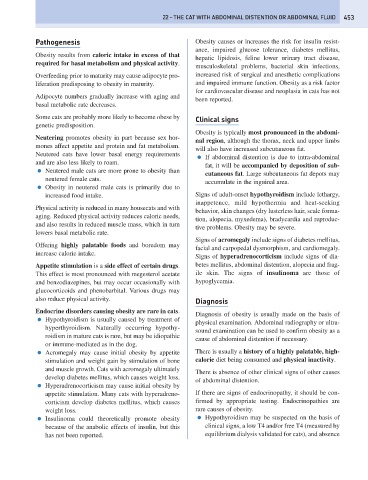Page 461 - Problem-Based Feline Medicine
P. 461
22 – THE CAT WITH ABDOMINAL DISTENTION OR ABDOMINAL FLUID 453
Pathogenesis Obesity causes or increases the risk for insulin resist-
ance, impaired glucose tolerance, diabetes mellitus,
Obesity results from caloric intake in excess of that
hepatic lipidosis, feline lower urinary tract disease,
required for basal metabolism and physical activity.
musculoskeletal problems, bacterial skin infections,
Overfeeding prior to maturity may cause adipocyte pro- increased risk of surgical and anesthetic complications
liferation predisposing to obesity in maturity. and impaired immune function. Obesity as a risk factor
for cardiovascular disease and neoplasia in cats has not
Adipocyte numbers gradually increase with aging and
been reported.
basal metabolic rate decreases.
Some cats are probably more likely to become obese by Clinical signs
genetic predisposition.
Obesity is typically most pronounced in the abdomi-
Neutering promotes obesity in part because sex hor-
nal region, although the thorax, neck and upper limbs
mones affect appetite and protein and fat metabolism.
will also have increased subcutaneous fat.
Neutered cats have lower basal energy requirements
● If abdominal distention is due to intra-abdominal
and are also less likely to roam.
fat, it will be accompanied by deposition of sub-
● Neutered male cats are more prone to obesity than
cutaneous fat. Large subcutaneous fat depots may
neutered female cats.
accumulate in the inguinal area.
● Obesity in neutered male cats is primarily due to
increased food intake. Signs of adult-onset hypothyroidism include lethargy,
inappetence, mild hypothermia and heat-seeking
Physical activity is reduced in many housecats and with
behavior, skin changes (dry lusterless hair, scale forma-
aging. Reduced physical activity reduces caloric needs,
tion, alopecia, myxedema), bradycardia and reproduc-
and also results in reduced muscle mass, which in turn
tive problems. Obesity may be severe.
lowers basal metabolic rate.
Signs of acromegaly include signs of diabetes mellitus,
Offering highly palatable foods and boredom may
facial and carpopedal dysmorphism, and cardiomegaly.
increase calorie intake.
Signs of hyperadrenocorticism include signs of dia-
Appetite stimulation is a side effect of certain drugs. betes mellitus, abdominal distention, alopecia and frag-
This effect is most pronounced with megesterol acetate ile skin. The signs of insulinoma are those of
and benzodiazepines, but may occur occasionally with hypoglycemia.
glucocorticoids and phenobarbital. Various drugs may
also reduce physical activity. Diagnosis
Endocrine disorders causing obesity are rare in cats.
Diagnosis of obesity is usually made on the basis of
● Hypothyroidism is usually caused by treatment of
physical examination. Abdominal radiography or ultra-
hyperthyroidism. Naturally occurring hypothy-
sound examination can be used to confirm obesity as a
roidism in mature cats is rare, but may be idiopathic
cause of abdominal distention if necessary.
or immune-mediated as in the dog.
● Acromegaly may cause initial obesity by appetite There is usually a history of a highly palatable, high-
stimulation and weight gain by stimulation of bone calorie diet being consumed and physical inactivity.
and muscle growth. Cats with acromegaly ultimately
There is absence of other clinical signs of other causes
develop diabetes mellitus, which causes weight loss.
of abdominal distention.
● Hyperadrenocorticism may cause initial obesity by
appetite stimulation. Many cats with hyperadreno- If there are signs of endocrinopathy, it should be con-
corticism develop diabetes mellitus, which causes firmed by appropriate testing. Endocrinopathies are
weight loss. rare causes of obesity.
● Insulinoma could theoretically promote obesity ● Hypothyroidism may be suspected on the basis of
because of the anabolic effects of insulin, but this clinical signs, a low T4 and/or free T4 (measured by
has not been reported. equilibrium dialysis validated for cats), and absence

